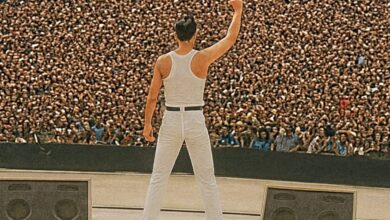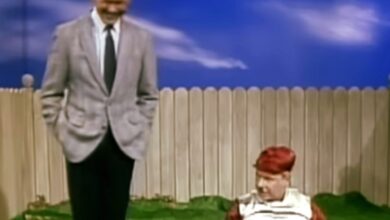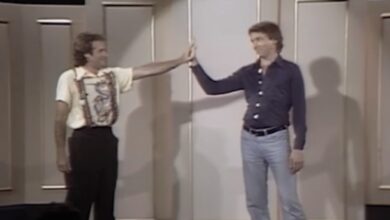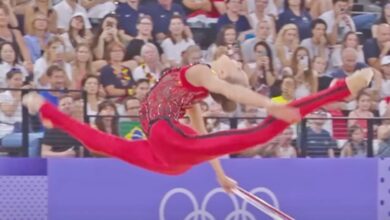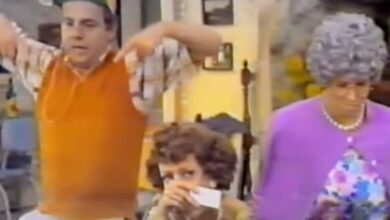Prince’s Unforgettable “Purple Rain” Super Bowl Halftime Performance
On February 4, 2007, during Super Bowl XLI in Miami Gardens, the skies opened up, and the world watched as Prince transformed a storm into a stage partner. The relentless rain drenched Dolphin Stadium, yet instead of retreating, he embraced it. Standing atop a platform cut in the shape of his Love Symbol, he delivered a performance that blended risk, spectacle, and raw artistry into one cinematic moment. No halftime before had ever faced such conditions, but instead of yielding to chaos, Prince turned the elements into art—his voice, his guitar, and the downpour composing a masterpiece before millions watching worldwide.
What unfolded that night wasn’t a concert—it was a live short film unfolding before our eyes. Lightning crackled, fireworks illuminated the sky, and the show exploded to life with Queen’s “We Will Rock You.” Prince’s energy was volcanic, his control effortless. He commanded the halftime stage like a veteran director shaping a film, balancing tight rhythm with open space for the camera to breathe. The rain didn’t hinder him; it added texture. His set became a fluid, ever-shifting narrative that turned twelve minutes of football halftime into timeless music television.
Even before that legendary moment, Prince’s approach hinted that this would be no ordinary halftime show. A week prior, he skipped the usual press conference and instead staged a mini-concert, signaling that art, not publicity, was his priority. The crew rehearsed his movements with tape outlines because the symbol-shaped stage wasn’t yet constructed, and once in Miami, Prince re-engineered every step with scientific precision. Those who witnessed it recall him walking the space in silence, studying where the lights would strike, and crafting a performance that would survive anything—even a thunderstorm.
His setlist wasn’t a random playlist—it was a deliberate story arc. Opening with “We Will Rock You,” he surged into “Let’s Go Crazy,” setting a fiery tone before mixing “Baby I’m a Star” and “1999” into a medley that built momentum like a rising tide. Then came a bold pivot: covers of “Proud Mary,” “All Along the Watchtower,” and even Foo Fighters’ “Best of You.” Each song reimagined its source, stitched together into one narrative that culminated with “Purple Rain.” When the final act arrived, so did destiny—the storm and the song meeting perfectly, as if scripted by the heavens.
As always, Prince thought beyond himself. He brought in the Florida A&M University Marching 100, their glowing uniforms cutting through the rain like neon brushstrokes. The spectacle fused the precision of HBCU pageantry with the swagger of Minneapolis funk. Every drum hit and brass flourish mirrored his movements, amplifying his performance instead of competing with it. The visual contrast—glittering water, luminous instruments, and Prince’s electric blue silhouette—made the field look less like a football arena and more like a dreamscape built for rhythm and rebellion.
The stage itself became part of the myth. Designed by Bruce Rogers, its glowing curves formed a lighted circuit beneath the rain, while camera cranes swung in arcs above. During key moments, a translucent screen rose behind Prince, turning his shadow into a mythic figure in motion. Television usually craves close-ups, but here, wide shots ruled—his outline against lightning, guitar neck slicing through mist, and every droplet catching a spark of light. The storm’s chaos painted the air with reflections, creating visuals so vivid they looked preordained.
Backstage, nerves ran high. Producers worried about cables shorting out and boots slipping on the slick acrylic floor. But then came the quote that would define the night. When someone asked Prince about the worsening weather, he smirked and said, “Can you make it rain harder?” That single sentence summed up everything about his approach—audacity, humor, and total control. While others fretted, he orchestrated chaos like a conductor. When the lights went live, every ounce of that confidence radiated outward, turning risk into theater.
Musically, the performance was a bridge between eras. “All Along the Watchtower” carried Hendrix’s spirit without imitation, “Proud Mary” honored the Turners’ energy, and “Best of You” transformed a 2000s rock anthem into a gospel cry for transcendence. Each track felt reborn under the Miami sky. His guitar tone cut through the rain like a lightning bolt—bright, soulful, and sharp enough to pierce every corner of the stadium. The sound wasn’t clean—it was alive, merging the organic noise of weather with the electricity of human will.
Safety crews and technicians faced their own battle behind the spectacle. The wet stage demanded a near-impossible balance of timing and precision. Dancers glided with practiced stability, and at one point, a crew member reportedly held a broken light connection by hand through the entire performance. The live-feed crew worked miracles, keeping the broadcast clear as water pooled beneath the performers. It was art and engineering in perfect sync—one mistake could have ruined everything, yet not a second faltered.
Then came the moment of transcendence. As purple lights bathed the stadium, a silk screen lifted behind Prince. His shadow—tall, elegant, and framed by lightning—stretched across the curtain while he struck the opening chords of “Purple Rain.” The audience erupted, ponchos gleaming like jewels under the light. The song rose, slow and spiritual, as real rain cascaded down. It wasn’t just a finale—it was a baptism. In that moment, the line between performer and myth blurred completely.
Critics responded with rare unanimity. Major outlets hailed the set as one of the most breathtaking halftime performances in history. The New York Times called it “pure theater,” while Rolling Stone dubbed it “perfection in the rain.” Fans flooded the internet with tributes, calling it “spiritual,” “otherworldly,” and “the greatest 12 minutes ever aired.” The next week, Prince’s record sales soared—proof that his music had once again crossed generations, inspiring both lifelong devotees and first-time listeners.
Years later, the legend still grows. Every January, the performance resurfaces across timelines and television retrospectives, replayed like a ritual. No matter how many drones, lasers, or holograms newer halftime shows employ, nothing matches the sight of Prince commanding thunder like an instrument. His legacy that night wasn’t built on spectacle alone—it was on authenticity, precision, and the audacious belief that real art doesn’t avoid risk; it dances with it. That’s why, even now, people don’t just remember it—they relive it.
@80sdeennice Prince sings “Purple Rain” (in the rain) in the greatest Super Bowl halftime show of all time 💜 ☔️ When the producers approached Prince before the set to warn him about the rain, he responded, “Can you make it rain harder?” #GOAT #SuperBowlXLI #2007 #prince #80sicon #80s #genx #80smusic #ilovethe80s #80skid #halftimeshow #purplerain #foryoupage ♬ original sound – 80s Deennice
